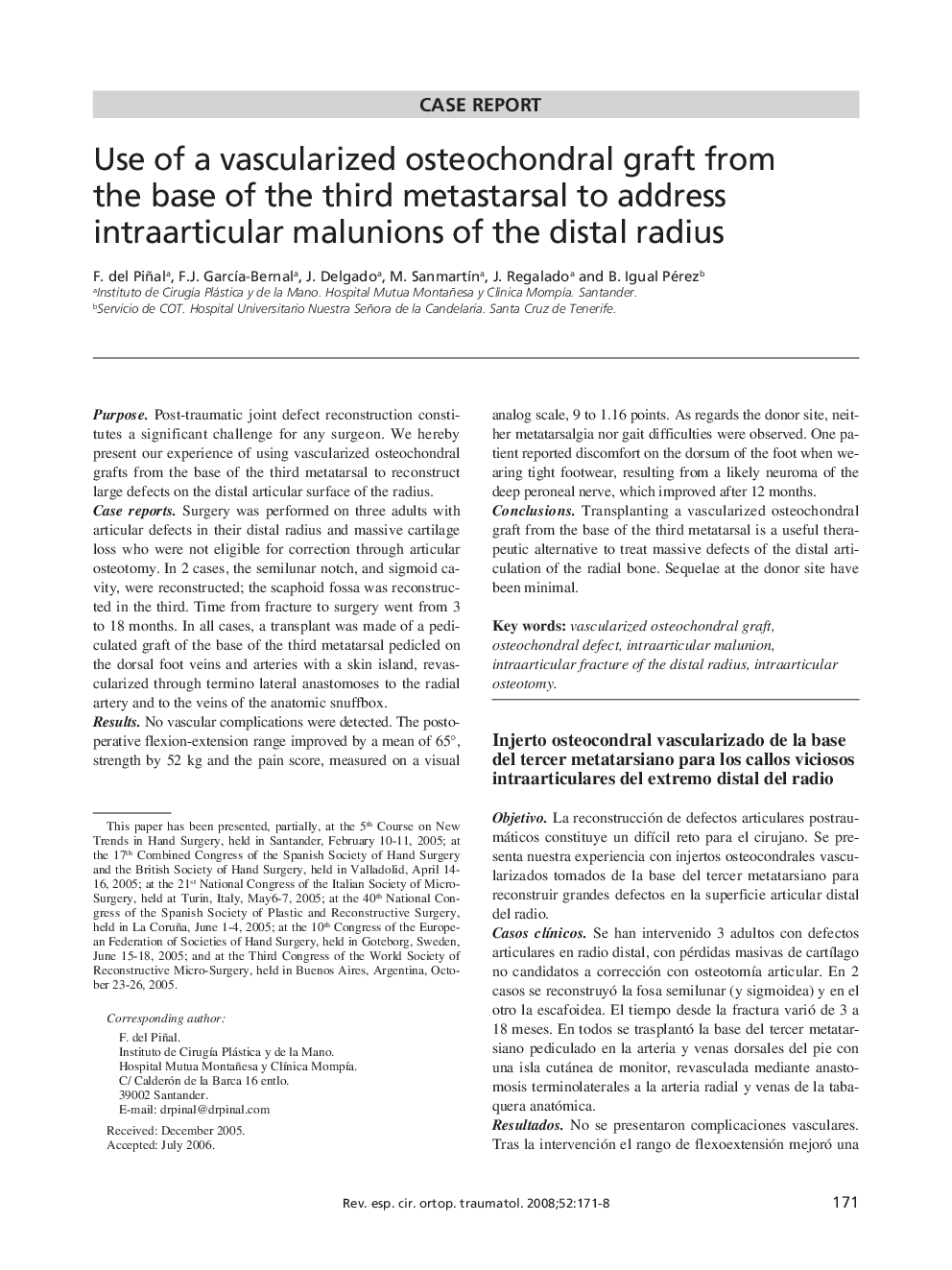| Article ID | Journal | Published Year | Pages | File Type |
|---|---|---|---|---|
| 4087766 | Revista Española de Cirugía Ortopédica y Traumatología (English Edition) | 2008 | 8 Pages |
PurposePost-traumatic joint defect reconstruction constitutes a significant challenge for any surgeon. We hereby present our experience of using vascularized osteochondral grafts from the base of the third metatarsal to reconstruct large defects on the distal articular surface of the radius.Case reportsSurgery was performed on three adults with articular defects in their distal radius and massive cartilage loss who were not eligible for correction through articular osteotomy. In 2 cases, the semilunar notch, and sigmoid cavity, were reconstructed; the scaphoid fossa was reconstructed in the third. Time from fracture to surgery went from 3 to 18 months. In all cases, a transplant was made of a pediculated graft of the base of the third metatarsal pedicled on the dorsal foot veins and arteries with a skin island, revascularized through termino lateral anastomoses to the radial artery and to the veins of the anatomic snuffbox.ResultsNo vascular complications were detected. The postoperative flexion-extension range improved by a mean of 65°, strength by 52 kg and the pain score, measured on a visual analog scale, 9 to 1.16 points. As regards the donor site, neither metatarsalgia nor gait difficulties were observed. One patient reported discomfort on the dorsum of the foot when wearing tight footwear, resulting from a likely neuroma of the deep peroneal nerve, which improved after 12 months.ConclusionsTransplanting a vascularized osteochondral graft from the base of the third metatarsal is a useful therapeutic alternative to treat massive defects of the distal articulation of the radial bone. Sequelae at the donor site have been minimal.
ObjetivoLa reconstrucción de defectos articulares postraumáticos constituye un difícil reto para el cirujano. Se presenta nuestra experiencia con injertos osteocondrales vascularizados tomados de la base del tercer metatarsiano para reconstruir grandes defectos en la superficie articular distal del radio.Casos clínicosSe han intervenido 3 adultos con defectos articulares en radio distal, con pérdidas masivas de cartílago no candidatos a corrección con osteotomía articular. En 2 casos se reconstruyó la fosa semilunar (y sigmoidea) y en el otro la escafoidea. El tiempo desde la fractura varió de 3 a 18 meses. En todos se trasplantó la base del tercer metatarsiano pediculado en la arteria y venas dorsales del pie con una isla cutánea de monitor, revasculada mediante anastomosis terminolaterales a la arteria radial y venas de la tabaquera anatómica.ResultadosNo se presentaron complicaciones vasculares. Tras la intervención el rango de flexoextensión mejoró una media de 65°; la fuerza, 52 kg y el dolor medio medido por una escala visual analógica pasó de 9 a 1,16. Respecto a la zona donante, no hubo problemas de metatarsalgia, ni en la marcha. Un paciente refería molestias en el dorso del pie, con el calzado apretado, por un probable neuroma del nervio peroneo profundo, que mejoró a los doce meses.ConclusionesEl trasplante de un injerto osteocondral vascularizado de la base del tercer metatarsiano constituye una alternativa terapéutica para el tratamiento de los defectos masivos de la carilla articular de radio distal. La secuela donante ha sido mínima.
